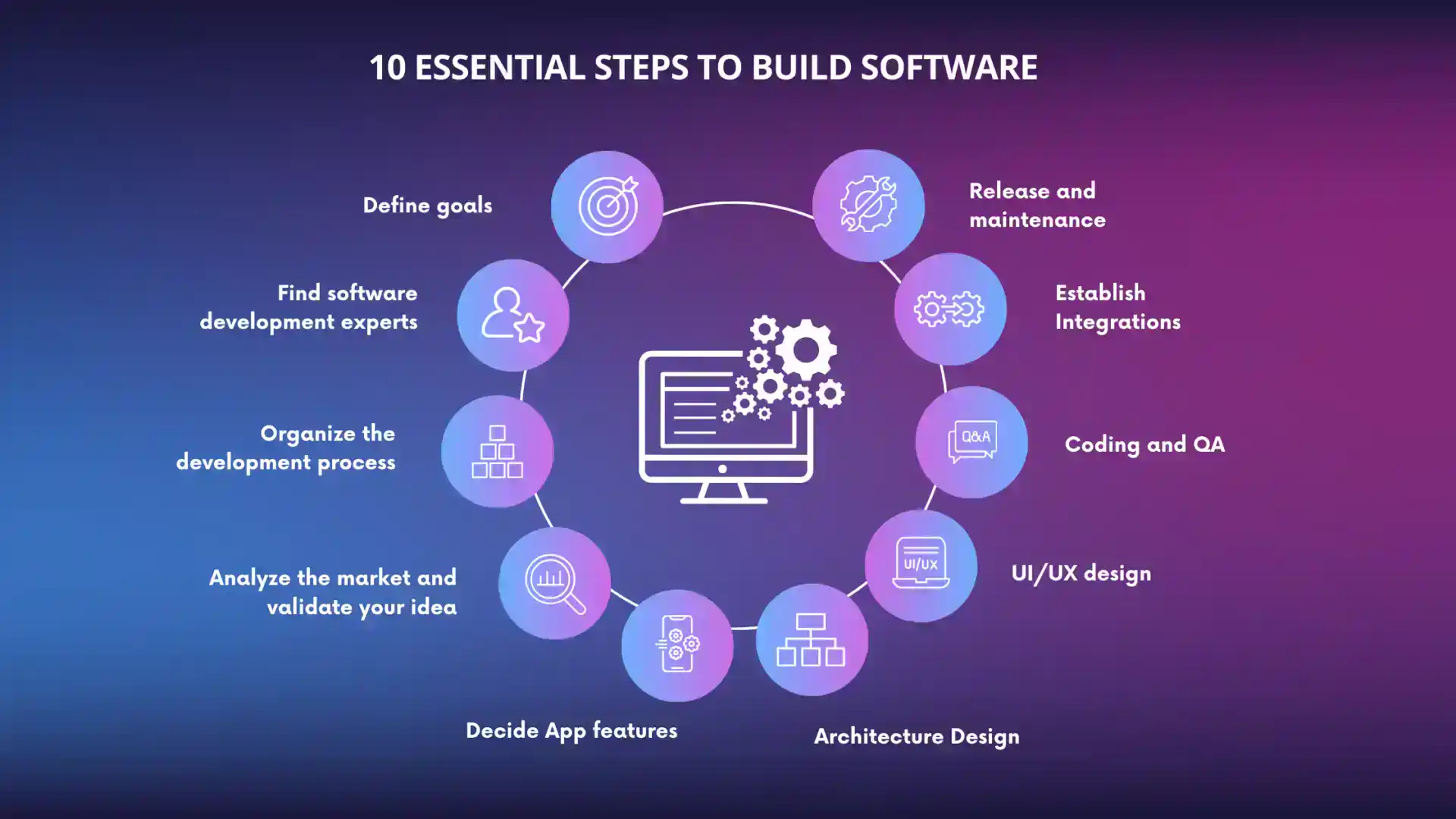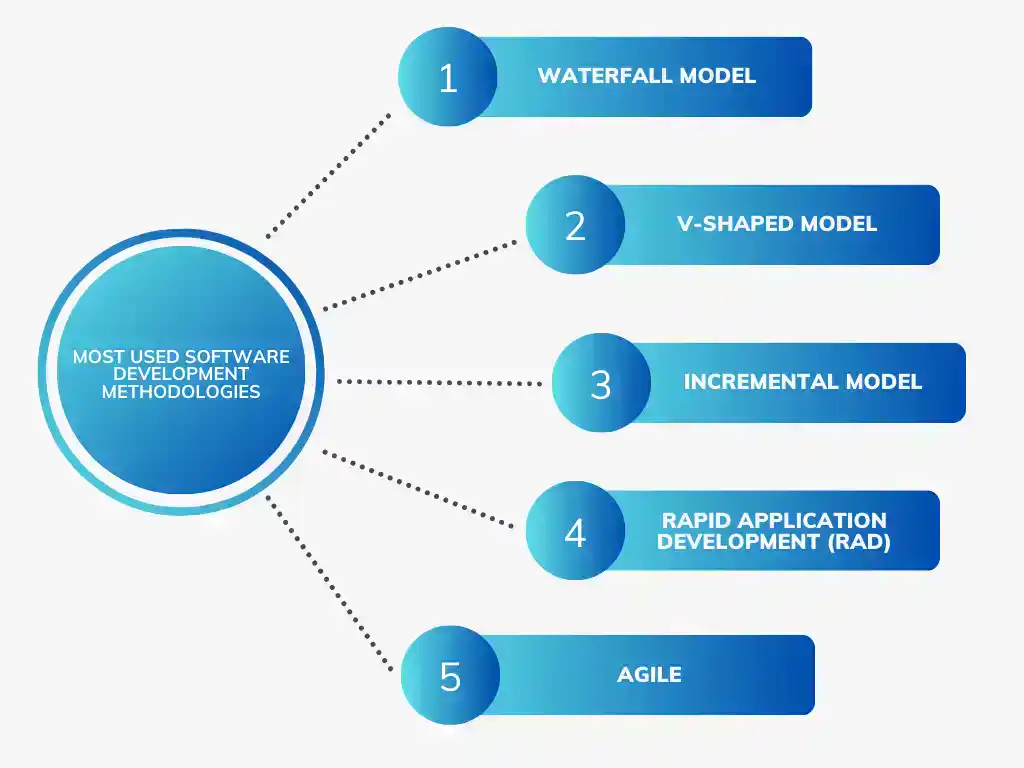Table of Contents
Navigating the Software Development Process: A Beginner’s Guide
In the digital realm, software serves as the backbone of our virtual interactions. From sleek mobile apps to robust web services, software is the silent force behind our daily digital dance. The craft of software development is a complex art that addresses intricate problems, boosts operational efficiency, and paves the way for business evolution.
Embarking on the journey to develop your software product is no small feat—it demands dedication, technical acumen, and a touch of creativity. It’s a voyage filled with challenges and learning curves, yet equally laden with excitement and the joy of creation.
This article unfolds the roadmap to crafting a software product that not only works flawlessly but also resolves real-world challenges and delights users with its functionality and user experience.
Decoding Software Development: 10 Essential Steps to build software

Step 1: Define Your Goals
This step is all about setting a clear direction for your software project:
- Identify the Problem: Start by pinpointing the problem your software aims to solve. Understand the pain points or challenges your target audience faces.
- Define Target Audience and Needs: Determine who your software’s primary users will be and what their specific needs are. What problems will your software address for them?
- Analyze Competitors: Study existing solutions or competitors in your niche. Identify what they offer and how your software can stand out, whether through better quality, more features, lower costs, or innovation.
- Calculate Gains: Consider the potential gains, both in terms of business profitability and user satisfaction, that your software can bring. This step helps you align your development efforts with your business objectives.
Step 2: Find Software Development Experts
Building the right team is crucial for success:
- Outsourcing Options: Explore different ways to hire remote development team, which may include outsourcing to third-party companies. Outsourcing allows you to leverage external expertise and resources while focusing on your core business activities.
- Outstaffing: This model provides you with dedicated remote developers who work as an extension of your team. You manage the development process while saving on recruitment and hiring efforts.
- Dedicated Team: Building an in-house development team can offer more control over your project but requires hiring and managing developers directly.
- Freelancers: Individual freelancers can be cost-effective but may require more effort in terms of finding the right people and managing them.
The choice of development team composition depends on your project’s complexity and requirements.
Step 3: Organize the Development Process
Selecting the right project management methodology is crucial:
- Agile: Agile methodologies emphasize collaboration, adaptability, and flexibility. Scrum, Kanban, and Extreme Programming are popular Agile frameworks. Agile projects deliver solutions iteratively, making it easier to adapt to changes and prioritize features based on feedback.
- Waterfall: Waterfall is a linear and sequential methodology where each phase must be completed before moving to the next. It relies heavily on clear documentation and may not be as flexible in accommodating changes.
Project management includes planning and execution, covering aspects such as scope, budget, timeframes, staff management, conflict resolution, and risk management.
Step 4: Analyze the Market and Validate Your Idea
Understanding your market and ensuring your idea is viable is essential:
- Contact Potential Clients: Engage with potential clients or leads to gauge their interest in your product or service. Gather feedback to refine your concept.
- Competitor Analysis: Continuously monitor and analyze your competitors. Understand their features, pricing, and market positioning.
- Invest in Marketing: Create an app marketing strategy to generate interest among your target audience. Building a community and involving potential users in the development process can foster engagement.
- Minimum Viable Product (MVP): Consider developing an MVP, a scaled-down version of your software, to quickly test your idea’s viability in the market.
- Analyze MVP Effectiveness: Once your MVP is live, measure its success using metrics and key performance indicators (KPIs). Use this data to identify areas for improvement.
Step 5: Decide Your App Features
Prioritize and define the essential features of your software:
- Usability: Ensure that your software’s design is intuitive and user-friendly. Users should find it easy to navigate and understand.
- Functionality: Your software should perform all the core tasks it was designed for without errors or issues.
- Reliability: Aim for stability and ensure your software is free from critical errors.
- Scalability: Design your software to accommodate growth, both in terms of data and user base.
- Security: Protect sensitive data and comply with data security regulations.
- Compatibility: Ensure your software works seamlessly with the intended operating systems, devices, and browsers.
- Flexibility: Design your software to adapt to changing requirements and emerging trends.
- Speed: Optimize your software’s performance to respond promptly to user actions.
- Support: Provide user documentation, feedback channels, and responsive customer support.
- Updates: Plan for regular updates, bug fixes, patches, and improvements.
Step 6: Architecture Design
This step involves creating the high-level structure of your software:
- Functional and Non-Functional Requirements: Carefully consider your software’s functional and non-functional requirements, as they shape your project’s scope.
- Tech Stack Selection: Choose the appropriate technology stack based on factors like applicability, community support, and scalability.
- Architecture Approach: Decide on the architecture approach that aligns with your project’s requirements, such as monolithic, microservices, or serverless architecture.
Step 7: UI/UX Design
Create wireframes and prototypes to ensure a user-friendly and visually appealing design:
- Wireframes: Develop low-fidelity representations of your software’s layout and structure to visualize its elements and arrangement.
- Prototypes: Create high-fidelity visualizations to reflect the look and feel of your software, potentially with interactive elements to demonstrate user flows.
- User-Centered Design: Focus on designing a user-centered interface that is accessible to all users, including those with impairments.
- Consistency: Maintain design consistency throughout your software, including typography, iconography, color schemes, and visual hierarchy.
Step 8: Coding and QA
This phase involves developing the software and ensuring its quality:
- Test-Driven Development (TDD): Base development decisions on test cases, ensuring functionality is verified through testing.
- CI/CD Pipelines: Implement continuous integration and continuous delivery pipelines to automate and streamline development processes.
- Code Readability: Write clean and readable code to facilitate debugging, onboarding, and future updates.
- Version Control: Use version control tools like Git or SVN to track changes and maintain code consistency.
- Backups and Crisis Management: Prepare for data loss and system failures by implementing regular backups and crisis management policies.
Step 9: Establish Integrations
Integrate your software with relevant systems and external resources:
- Corporate Apps: Connect your software to corporate systems such as CRM, ERP, and accounting software.
- External Data Sources: Import data from external sources relevant to your software’s operations.
- Third-Party Services: Integrate third-party services for functions like authentication, payment processing, and messaging.
- Hardware: If applicable, integrate your software with hardware devices or tools.
Step 10: Release and Maintenance
This final step involves releasing your software and ensuring its ongoing success:
- Release: Launch your software and monitor its performance.
- Updates and Maintenance: Continuously provide updates, bug fixes, patches, and improvements based on user feedback and changing requirements.
- Software Development Life Cycle (SDLC): Understand that the software development process is iterative and may involve multiple releases and ongoing maintenance. To build software and to maintain it both has its own importance.
Factors Affecting Software Development Costs
Several factors can impact the cost to build software:
- Artificial Intelligence: The use of AI tools can reduce development time and costs by automating tasks like code generation, syntax correction, and bug minimization.
- Type of Work: The nature of the project, whether it’s development from scratch, legacy system modernization, cloud migration, or system integration, can significantly affect costs.
- Type of Solutions: Different software solutions, such as content management systems (CMS), enterprise resource planning (ERP) systems, or customer relationship management (CRM) systems, have varying development costs.
- Project’s Business Domain: Projects in industries like finance and banking tend to be more expensive due to higher security requirements and complexity.
- Project’s Complexity and Scope: The number of functionalities, their intricacy, and customization level impact costs. Projects are categorized as small, medium, large, or enterprise based on complexity.
- Platform: Building for multiple platforms, like Android and iOS, can increase costs compared to cross-platform development.
- UI/UX Design: High-quality user interface and user experience design can add to development costs but are crucial for user adoption.
- Back-end: Developing a robust back-end architecture and integrating with third-party resources can affect costs.
- Integrations: The need for integrating software with APIs, payment gateways, or other modules can impact development expenses.
- Tech Stack: The choice of programming languages and technologies can affect both development time and costs.
- Team Composition: The size and expertise of your development team can vary based on project complexity, influencing costs.
Most Used Software Development Methodologies
Software development methodologies define how projects are planned and executed. Here are some common methodologies:
- Waterfall Model: A linear, sequential approach where each phase must be completed before the next begins. It’s less flexible but relies on clear documentation.
- V-Shaped Model: Similar to the waterfall model but emphasizes testing at each phase.
- Incremental Model: The project is divided into smaller segments or increments, with each increment adding new functionality.
- Rapid Application Development (RAD): Emphasizes rapid prototyping and quick feedback.
- Agile: A flexible, iterative approach that focuses on collaboration, adaptability, and swift changes.

In 2022, nearly half of those surveyed have adopted the DevOps or DevSecOps approach for software development. This methodology merges the operations and development divisions within IT, aiming to achieve a rapid and consistent delivery cycle, all while maintaining a high standard of software quality. The preference for DevOps is driven by the desire for quicker market launch times, enhanced security measures, superior code quality, and the facilitation of better communication and collaboration among development teams.
Conclusion
Building software is a multifaceted process that requires careful planning, skilled teams, and adherence to best practices. Whether you’re creating a groundbreaking startup app or modernizing existing systems, understanding the steps and factors involved in software development is crucial for success. By following these guidelines and considering the key factors that affect costs, you can embark on your software development journey with confidence and the potential to create a valuable and innovative product.
Join hand with HyScaler for step to step guide in your software development process.